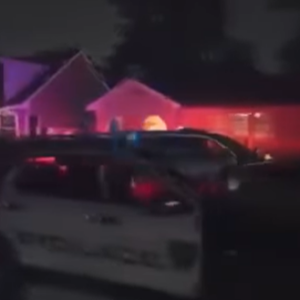Most drivers are familiar with the universally recognized red, octagonal stop sign that marks intersections across the country. Its bold red color and white lettering have become a near-instant signal to hit the brakes and come to a complete stop. But encountering a blue stop sign can be both surprising and confusing, especially for those who have only ever seen the standard red version. While these signs do exist, they are not used on public roads and do not follow the same rules and standards set for official traffic control devices.
In the United States, all official road signs are governed by the Manual on Uniform Traffic Control Devices (MUTCD), which outlines the size, shape, color, and placement of every sign. Under these federal regulations, stop signs must be red with white lettering. The color choice is deliberate: red is highly visible at a distance, stands out in various weather conditions, and is strongly associated with danger, urgency, and the need for immediate action. This psychological link between the color red and stopping has been reinforced for decades, making the red stop sign one of the most recognized symbols in the world.
Blue stop signs, on the other hand, fall outside of these official guidelines. They are most commonly found in private areas such as gated communities, private residential neighborhoods, college or corporate campuses, and large commercial parking lots. These areas are not regulated in the same way as public roads, allowing property owners to install nonstandard signs. The intent is still to control traffic and maintain safety, but because these signs are unofficial, they do not carry the same legal enforcement as those found on public streets.
Understanding the color conventions for traffic signs can help explain why blue stop signs are so unusual. Each color serves a specific purpose:
Red indicates stop, prohibition, or the need for immediate attention.
Yellow warns of potential hazards ahead.
Green provides directional guidance or indicates permitted movements.
Blue is reserved for informational signs, such as those marking rest areas, hospitals, or parking zones.
Black and white typically denote regulations, like speed limits or lane use.
A blue stop sign therefore breaks with the established system, which can lead to hesitation or confusion for drivers seeing it for the first time. In unfamiliar environments, that moment of uncertainty could potentially cause problems, especially if other drivers are expecting consistent behavior at intersections.
Despite their unofficial status, blue stop signs should never be ignored. On private property, failing to stop could lead to collisions, near misses, or issues with property management and security personnel. In some cases, local rules or contracts—such as those in homeowners’ associations—may require adherence to posted signs, even if they don’t meet federal standards.
The safest approach is to treat any stop sign, regardless of color, as if it were the standard red version. Coming to a complete stop, checking for pedestrians and cross traffic, and proceeding only when it’s safe ensures that you protect yourself, your passengers, and others on the road. While blue stop signs may not carry the same legal authority, their purpose remains the same: to keep traffic orderly, reduce risk, and maintain safety for everyone.
If you ever encounter one, let it serve as a reminder that safety doesn’t depend solely on rules and regulations—it also relies on driver awareness and courtesy. No matter what color the sign may be, the message is clear: stop, look, and proceed with care.




